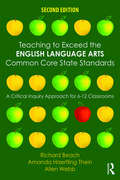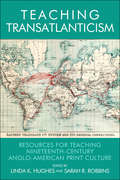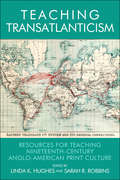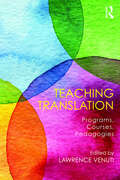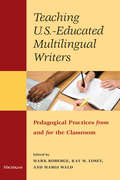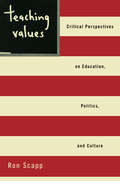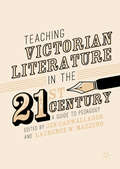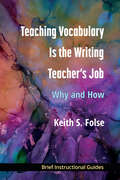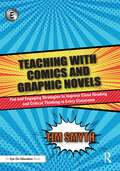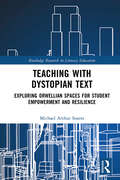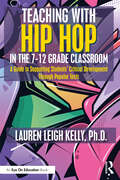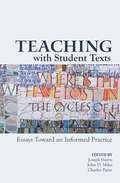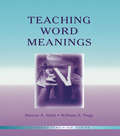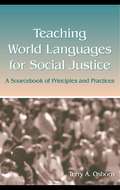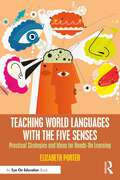- Table View
- List View
Teaching to Exceed the English Language Arts Common Core State Standards: A Critical Inquiry Approach for 6-12 Classrooms
by Richard Beach Amanda Haertling Thein Allen WebbTimely, thoughtful, and comprehensive, this text directly supports pre-service and in-service teachers in developing curriculum and instruction that both addresses and exceeds the requirements of the Common Core State Standards. Adopting a critical inquiry approach, it demonstrates how the Standards’ highest and best intentions for student success can be implemented from a critical, culturally relevant perspective firmly grounded in current literacy learning theory and research. It provides specific examples of teachers using the critical inquiry curriculum framework of identifying problems and issues, adopting alternative perspectives, and entertaining change in their classrooms to illustrate how the Standards can not only be addressed but also surpassed through engaging instruction. The Second Edition provides new material on adopting a critical inquiry approach to enhance student engagement and critical thinking planning instruction to effectively implement the CCSS in the classroom fostering critical response to literary and informational texts using YA literature and literature by authors of color integrating drama activities into literature and speaking/listening instruction teaching informational, explanatory, argumentative, and narrative writing working with ELL students to address the language Standards using digital tools and apps to respond to and create digital texts employing formative assessment to provide supportive feedback preparing students for the PARCC and Smarter Balanced assessments using the book’s wiki site http://englishccss.pbworks.com for further resources
Teaching Transatlanticism: Resources for Teaching Nineteenth-Century Anglo-American Print Culture
by Linda Hughes Sarah RobbinsAn essential resource for teaching 19th-century print culture in Transatlantic Studies The 18 chapters in this book outline conceptual approaches to the field and provide practical resources for teaching, ranging from ideas for individual class sessions to full syllabi and curricular frameworks. The book is divided into 5 key sections: Curricular Histories and Key Trends; Organising Curriculum through Transatlantic Lenses; Teaching Transatlantic Figures; Teaching Genres in Transatlantic Context; and Envisioning Digital Transatlanticism. Individual chapters from experts in the field range from reconceptualising entire courses to revisiting individual texts, authors, and genres in a transatlantic context. Weaving in strategies from innovative teaching shaped by the digital humanities, the collection also looks ahead to the future of this growing field.
Teaching Transatlanticism: Resources for Teaching 19th-Century Anglo-American Print Culture
by Linda Hughes Sarah RobbinsAn essential resource for teaching 19th-century print culture in Transatlantic Studies The 18 chapters in this book outline conceptual approaches to the field and provide practical resources for teaching, ranging from ideas for individual class sessions to full syllabi and curricular frameworks. The book is divided into 5 key sections: Curricular Histories and Key Trends; Organising Curriculum through Transatlantic Lenses; Teaching Transatlantic Figures; Teaching Genres in Transatlantic Context; and Envisioning Digital Transatlanticism. Individual chapters from experts in the field range from reconceptualising entire courses to revisiting individual texts, authors, and genres in a transatlantic context. Weaving in strategies from innovative teaching shaped by the digital humanities, the collection also looks ahead to the future of this growing field.
Teaching Translation: Programs, courses, pedagogies
by Lawrence VenutiOver the past half century, translation studies has emerged decisively as an academic field around the world, and in recent years the number of academic institutions offering instruction in translation has risen along with an increased demand for translators, interpreters and translator trainers. Teaching Translation is the most comprehensive and theoretically informed overview of current translation teaching. Contributions from leading figures in translation studies are preceded by a substantial introduction by Lawrence Venuti, in which he presents a view of translation as the ultimate humanistic task – an interpretive act that varies the form, meaning, and effect of the source text. 26 incisive chapters are divided into four parts, covering: certificate and degree programs teaching translation practices studying translation theory, history, and practice surveys of translation pedagogies and key textbooks The chapters describe long-standing programs and courses in the US, Canada, the UK, and Spain, and each one presents an exemplary model for teaching that can be replicated or adapted in other institutions. Each contributor responds to fundamental questions at the core of any translation course – for example, how is translation defined? What qualifies students for admission to the course? What impact does the institutional site have upon the course or pedagogy? Teaching Translation will be relevant for all those working and teaching in the areas of translation and translation studies. Additional resources for Translation and Interpreting Studies are available on the Routledge Translation Studies Portal.
Teaching Translation: Programs, courses, pedagogies
by Lawrence VenutiOver the past half century, translation studies has emerged decisively as an academic field around the world, and in recent years the number of academic institutions offering instruction in translation has risen along with an increased demand for translators, interpreters and translator trainers. Teaching Translation is the most comprehensive and theoretically informed overview of current translation teaching. Contributions from leading figures in translation studies are preceded by a substantial introduction by Lawrence Venuti, in which he presents a view of translation as the ultimate humanistic task – an interpretive act that varies the form, meaning, and effect of the source text. 26 incisive chapters are divided into four parts, covering: certificate and degree programs teaching translation practices studying translation theory, history, and practice surveys of translation pedagogies and key textbooks The chapters describe long-standing programs and courses in the US, Canada, the UK, and Spain, and each one presents an exemplary model for teaching that can be replicated or adapted in other institutions. Each contributor responds to fundamental questions at the core of any translation course – for example, how is translation defined? What qualifies students for admission to the course? What impact does the institutional site have upon the course or pedagogy? Teaching Translation will be relevant for all those working and teaching in the areas of translation and translation studies. Additional resources for Translation and Interpreting Studies are available on the Routledge Translation Studies Portal.
Teaching U.S.-Educated Multilingual Writers: Pedagogical Practices from and for the Classroom
by Roberge Mark Losey Kay M. Wald MargiThis volume was born to address the lack of classroom-oriented scholarship regarding U.S.-educated multilingual writers. Unlike prior volumes about U.S.-educated multilinguals, this book focuses solely on pedagogy--from classroom activities and writing assignments to course curricula and pedagogical support programs outside the immediate classroom. Unlike many pedagogical volumes that are written in the voice of an expert researcher-theorist, this volume is based on the notion of teachers sharing practices with teachers. All of the contributors are teachers who are writing about and reflecting on their own experiences and outcomes and interweaving those experiences and outcomes with current theory and research in the field. The volume thus portrays teachers as active, reflective participants engaged in critical inquiry. Contributors represent community college, college, and university contexts; academic ESL, developmental writing, and first-year composition classes; and face-to-face, hybrid, and online contexts. This book was developed primarily to meet the needs of practicing writing teachers in college-level ESL, basic writing, and college composition classrooms, but will also be useful to pre-service teachers in TESOL, Composition, and Education graduate programs.
Teaching Values: Critical Perspectives on Education, Politics, and Culture
by Ron ScappIn Teaching Values, Ron Scapp wrests the discussion of values and values-based education away from traditionalists who have long dominated educational debates. While challenging the Right's domination of the discussion of values education, Scapp examines some issues not typically raised by educators and critics on the Left, including the positive role of citizenship and national identity in U.S. education and culture.
Teaching Values: Critical Perspectives on Education, Politics, and Culture
by Ron ScappIn Teaching Values, Ron Scapp wrests the discussion of values and values-based education away from traditionalists who have long dominated educational debates. While challenging the Right's domination of the discussion of values education, Scapp examines some issues not typically raised by educators and critics on the Left, including the positive role of citizenship and national identity in U.S. education and culture.
Teaching Victorian Literature in the Twenty-First Century
by Jen Cadwallader Laurence W MazzenoThis edited collection offers undergraduate Literature instructors a guide to the pedagogy and teaching of Victorian literature in liberal arts classrooms. With numerous essays focused on thematic course design, this volume reflects the increasingly interdisciplinary nature of the literature classroom. A section on genre provides suggestions on approaching individual works and discussing their influence on production of texts. Sections on digital humanities and "out of the classroom" approaches to Victorian literature reflect current practices and developing trends. The concluding section offers three different versions of an "ideal" course, each of which shows how thematic, disciplinary, genre, and technological strands may be woven together in meaningful ways. Professors of introductory literature courses aimed at non-English majors to advanced seminars for majors will find accessible and innovative course ideas supplemented with a variety of versatile teaching materials, including syllabi, assignments, and in-class activities.
Teaching Victorian Literature in the Twenty-First Century: A Guide to Pedagogy (PDF)
by Jen Cadwallader Laurence W MazzenoThis edited collection offers undergraduate Literature instructors a guide to the pedagogy and teaching of Victorian literature in liberal arts classrooms. With numerous essays focused on thematic course design, this volume reflects the increasingly interdisciplinary nature of the literature classroom. A section on genre provides suggestions on approaching individual works and discussing their influence on production of texts. Sections on digital humanities and “out of the classroom” approaches to Victorian literature reflect current practices and developing trends. The concluding section offers three different versions of an “ideal” course, each of which shows how thematic, disciplinary, genre, and technological strands may be woven together in meaningful ways. Professors of introductory literature courses aimed at non-English majors to advanced seminars for majors will find accessible and innovative course ideas supplemented with a variety of versatile teaching materials, including syllabi, assignments, and in-class activities.
Teaching Vocabulary Is the Writing Teacher's Job: Why and How
by Keith S. FolseWhile most teachers acknowledge the importance of vocabulary in learning a new language, many assume a reading class or other teacher will cover vocabulary. Yet vocabulary plays an essential role in good writing, especially academic writing. Teaching Vocabulary Is the Writing Teacher’s Job explores the serious nature of ESL students’ lexical plight and looks at vocabulary in relation to reading, speaking, listening, and writing proficiency. It also examines the role of vocabulary in ESL writing assessment. In the conclusion, author Keith Folse discusses eight research-based suggestions for writing teachers, including encouraging students to become vocabulary detectives, teaching collocations, testing vocabulary, and teaching paraphrasing and summarizing.
Teaching with Comics and Graphic Novels: Fun and Engaging Strategies to Improve Close Reading and Critical Thinking in Every Classroom
by Tim Smyth35th Annual Will Eisner Comic Industry Awards Nominee! This text will allow you to harness students’ love of comics and graphic novels while increasing critical thinking and engagement in the classroom. Author Tim Smyth offers a wide variety of lessons and ideas for using comics to teach close reading, working with textual evidence, literature adaptations, symbolism and culture, sequencing, essay writing, and more. He also models how to use comics to tackle tough topics and enhance social-emotional learning. Throughout the book, you’ll find a multitude of practical resources, including a variety of lesson plans—some quick and easy activities as well as more detailed ready-to-use unit plans. These thoughtful lessons meet the Common Core State Standards and are easy to adapt for any subject area or grade level to fit into your curriculum. Add this book to your professional library and you’ll have a new and exciting way of reaching and teaching your students!
Teaching with Comics and Graphic Novels: Fun and Engaging Strategies to Improve Close Reading and Critical Thinking in Every Classroom
by Tim Smyth35th Annual Will Eisner Comic Industry Awards Nominee! This text will allow you to harness students’ love of comics and graphic novels while increasing critical thinking and engagement in the classroom. Author Tim Smyth offers a wide variety of lessons and ideas for using comics to teach close reading, working with textual evidence, literature adaptations, symbolism and culture, sequencing, essay writing, and more. He also models how to use comics to tackle tough topics and enhance social-emotional learning. Throughout the book, you’ll find a multitude of practical resources, including a variety of lesson plans—some quick and easy activities as well as more detailed ready-to-use unit plans. These thoughtful lessons meet the Common Core State Standards and are easy to adapt for any subject area or grade level to fit into your curriculum. Add this book to your professional library and you’ll have a new and exciting way of reaching and teaching your students!
Teaching with Dystopian Text: Exploring Orwellian Spaces for Student Empowerment and Resilience (Routledge Research in Literacy Education)
by Michael Arthur SoaresTeaching with Dystopian Text propounds an exchange of spatial to pedagogical practices centered around “Orwellian Spaces,” signaling a new utility for teaching with dystopian texts in secondary education. The volume details the urgency of dystopian texts for secondary students, providing theoretical frameworks, classroom examples and practical research. The function of dystopian texts, such as George Orwell’s 1984, as social and political critique is demonstrated as central to their power. Teaching with Dystopian Text: Exploring Orwellian Spaces for Student Empowerment and Resilience makes a case that dystopian texts can be instrumental in the transfer of spatial practices to pedagogical practices. Pedagogical application creates links between the text and the student through defamiliarization, connecting the student to practices of resistance in the space of the classroom. The volume also addresses the challenges of teaching dystopian text in a dystopian educational climate including the COVID-19 lockdown. In addition to appealing to scholars and researchers of literacy education, language education and dystopian text, this book will also be a powerful yet accessible resource for secondary teachers as they address dystopian concerns with students in the complicated twenty-first century.
Teaching with Dystopian Text: Exploring Orwellian Spaces for Student Empowerment and Resilience (Routledge Research in Literacy Education)
by Michael Arthur SoaresTeaching with Dystopian Text propounds an exchange of spatial to pedagogical practices centered around “Orwellian Spaces,” signaling a new utility for teaching with dystopian texts in secondary education. The volume details the urgency of dystopian texts for secondary students, providing theoretical frameworks, classroom examples and practical research. The function of dystopian texts, such as George Orwell’s 1984, as social and political critique is demonstrated as central to their power. Teaching with Dystopian Text: Exploring Orwellian Spaces for Student Empowerment and Resilience makes a case that dystopian texts can be instrumental in the transfer of spatial practices to pedagogical practices. Pedagogical application creates links between the text and the student through defamiliarization, connecting the student to practices of resistance in the space of the classroom. The volume also addresses the challenges of teaching dystopian text in a dystopian educational climate including the COVID-19 lockdown. In addition to appealing to scholars and researchers of literacy education, language education and dystopian text, this book will also be a powerful yet accessible resource for secondary teachers as they address dystopian concerns with students in the complicated twenty-first century.
Teaching with Hip Hop in the 7-12 Grade Classroom: A Guide to Supporting Students’ Critical Development Through Popular Texts
by Lauren Leigh KellyThis book presents practical approaches for engaging with Hip Hop music and culture in the classroom. As the most popular form of music and youth culture today, Hip Hop is a powerful medium through which students can explore their identities and locate themselves in our social world. Designed for novice and veteran teachers, this book is filled with pedagogical tools, strategies, lesson plans, and real-world guidance on integrating Hip Hop into the curriculum. Through a wide range of approaches and insights, Lauren Leigh Kelly invites teachers to look to popular media culture to support students’ development and critical engagement with texts. Covering classroom practice, assessment strategies, and curricular and standards-based guidelines, the lessons in this book will bolster students’ linguistic and critical thinking skills and help students to better understand and act upon the societal forces around them. The varied activities, assignments, and handouts are designed to inspire teachers and easily facilitate modification of the assignments to suit their own contexts. The impact of Hip Hop on youth culture is undeniable, now more than ever; this is the perfect book for teachers who want to connect with their students, support meaning-making in the classroom, affirm the validity of youth culture, and foster an inclusive and engaging classroom environment.
Teaching with Hip Hop in the 7-12 Grade Classroom: A Guide to Supporting Students’ Critical Development Through Popular Texts
by Lauren Leigh KellyThis book presents practical approaches for engaging with Hip Hop music and culture in the classroom. As the most popular form of music and youth culture today, Hip Hop is a powerful medium through which students can explore their identities and locate themselves in our social world. Designed for novice and veteran teachers, this book is filled with pedagogical tools, strategies, lesson plans, and real-world guidance on integrating Hip Hop into the curriculum. Through a wide range of approaches and insights, Lauren Leigh Kelly invites teachers to look to popular media culture to support students’ development and critical engagement with texts. Covering classroom practice, assessment strategies, and curricular and standards-based guidelines, the lessons in this book will bolster students’ linguistic and critical thinking skills and help students to better understand and act upon the societal forces around them. The varied activities, assignments, and handouts are designed to inspire teachers and easily facilitate modification of the assignments to suit their own contexts. The impact of Hip Hop on youth culture is undeniable, now more than ever; this is the perfect book for teachers who want to connect with their students, support meaning-making in the classroom, affirm the validity of youth culture, and foster an inclusive and engaging classroom environment.
Teaching With Student Texts: Essays Toward an Informed Practice
by Joseph Harris John D. Miles Charles PaineHarris, Miles and Paine ask: What happens when the texts that students write become the focus of a writing course? In response, a distinguished group of scholar/teachers suggests that teaching with students texts is not simply a classroom technique, but a way of working with writing that defines composition as a field. In Teaching with Student Texts, authors discuss ways of revaluing student writing as intellectual work, of circulating student texts in the classroom and beyond, and of changing our classroom practices by bringing student writings to the table. Together, these essays articulate a variety of ways that student texts can take a central place in classroom work and can, in the process, redefine the ways our field talks about writing.
Teaching Word Meanings (Literacy Teaching Series)
by Steven A. Stahl William E. NagyLearning new words is foundational to success in school and life. Researchers have known for years that how many word meanings a student knows is one of the strongest predictors of how well that student will understand text and be able to communicate through writing. This book is about how children learn the meanings of new words (and the concepts they convey) and how teachers can be strategic in deciding which words to teach, how to teach them, and which words not to teach at all.This book offers a comprehensive approach to vocabulary instruction. It offers not just practical classroom activities for teaching words (though plenty of those are included), but ways that teachers can make the entire curriculum more effective at promoting students' vocabulary growth. It covers the 'why to' and 'when to' as well as the 'how to' of teaching word meanings.Key features of this exciting new book include:*A variety of vocabulary activities. Activities for teaching different kinds of words such as high frequency words, high utility words, and new concepts, are explained and illustrated.*Guidelines for choosing words. A chart provides a simple framework built around seven basic categories of words that helps teachers decide which words to teach and how to teach them.*Word learning strategies. Strategies are offered that will help students use context, word parts, and dictionaries more effectively.*Developing Word Consciousness. Although specific vocabulary instruction is fully covered, the primary goal of this book is to develop students' independent interest in words and their motivation to learn them.*Integrated Vocabulary Instruction. Teachers are encouraged to improve the reading vocabularies of their students by looking for opportunities to integrate vocabulary learning into activities that are undertaken for other purposes.
Teaching Word Meanings (Literacy Teaching Series)
by Steven A. Stahl William E. NagyLearning new words is foundational to success in school and life. Researchers have known for years that how many word meanings a student knows is one of the strongest predictors of how well that student will understand text and be able to communicate through writing. This book is about how children learn the meanings of new words (and the concepts they convey) and how teachers can be strategic in deciding which words to teach, how to teach them, and which words not to teach at all.This book offers a comprehensive approach to vocabulary instruction. It offers not just practical classroom activities for teaching words (though plenty of those are included), but ways that teachers can make the entire curriculum more effective at promoting students' vocabulary growth. It covers the 'why to' and 'when to' as well as the 'how to' of teaching word meanings.Key features of this exciting new book include:*A variety of vocabulary activities. Activities for teaching different kinds of words such as high frequency words, high utility words, and new concepts, are explained and illustrated.*Guidelines for choosing words. A chart provides a simple framework built around seven basic categories of words that helps teachers decide which words to teach and how to teach them.*Word learning strategies. Strategies are offered that will help students use context, word parts, and dictionaries more effectively.*Developing Word Consciousness. Although specific vocabulary instruction is fully covered, the primary goal of this book is to develop students' independent interest in words and their motivation to learn them.*Integrated Vocabulary Instruction. Teachers are encouraged to improve the reading vocabularies of their students by looking for opportunities to integrate vocabulary learning into activities that are undertaken for other purposes.
Teaching World Languages for Social Justice: A Sourcebook of Principles and Practices
by Terry A. OsbornTeaching World Languages for Social Justice: A Sourcebook of Principles and Practices offers principles based on theory, and innovative concepts, approaches, and practices illustrated through concrete examples, for promoting social justice and developing a critical praxis in foreign language classrooms in the U.S. and in wider world language communities. For educators seeking to translate these ideals into classroom practice in an environment dominated by the current standards movement and accountability measures, the critical insights on language education offered in this text will be widely welcomed.The text is designed as a sourcebook for translating theory into practice. Each chapter includes the theoretical base, guidelines for practice, discussion of the relationship to existing practices in the world language classroom, suggestions for activity development (which can be integrated into a professional portfolio), illustrative examples, questions for reflection, and additional suggested readings.Teaching World Languages for Social Justice is a primary or supplementary text for second and foreign language teaching methods courses and is equally appropriate for graduate courses in language education or educational studies.
Teaching World Languages for Social Justice: A Sourcebook of Principles and Practices
by Terry A. OsbornTeaching World Languages for Social Justice: A Sourcebook of Principles and Practices offers principles based on theory, and innovative concepts, approaches, and practices illustrated through concrete examples, for promoting social justice and developing a critical praxis in foreign language classrooms in the U.S. and in wider world language communities. For educators seeking to translate these ideals into classroom practice in an environment dominated by the current standards movement and accountability measures, the critical insights on language education offered in this text will be widely welcomed.The text is designed as a sourcebook for translating theory into practice. Each chapter includes the theoretical base, guidelines for practice, discussion of the relationship to existing practices in the world language classroom, suggestions for activity development (which can be integrated into a professional portfolio), illustrative examples, questions for reflection, and additional suggested readings.Teaching World Languages for Social Justice is a primary or supplementary text for second and foreign language teaching methods courses and is equally appropriate for graduate courses in language education or educational studies.
Teaching World Languages with the Five Senses: Practical Strategies and Ideas for Hands-On Learning
by Elizabeth PorterWith this fun, practical guide, you will have everything you need to re-envision and reinvigorate your world language classroom. Author Elizabeth Porter draws on a brain-based approach to show how language learning is a sensory experience. Students can effectively learn languages and improve retention through activities and lessons that incorporate the five senses – sight, hearing, taste, touch, and smell. Chapters include real-world, research-backed examples and classroom strategies and activities ready for use. An essential resource for world language teachers, this book introduces language learning philosophy and an out-of-the-box, effective approach that uses neuroscience combined with best practices to promote a highly engaging language learning environment.
Teaching World Languages with the Five Senses: Practical Strategies and Ideas for Hands-On Learning
by Elizabeth PorterWith this fun, practical guide, you will have everything you need to re-envision and reinvigorate your world language classroom. Author Elizabeth Porter draws on a brain-based approach to show how language learning is a sensory experience. Students can effectively learn languages and improve retention through activities and lessons that incorporate the five senses – sight, hearing, taste, touch, and smell. Chapters include real-world, research-backed examples and classroom strategies and activities ready for use. An essential resource for world language teachers, this book introduces language learning philosophy and an out-of-the-box, effective approach that uses neuroscience combined with best practices to promote a highly engaging language learning environment.
Teaching Writing: Effective approaches for the middle years
by Tessa DaffernIn the 21st century, writing is more important than at any other time in human history. Yet much of the emphasis in schooling has been on reading, and after the early years, writing skills have been given less attention. Internationally, too many children are leaving school without the writing skills they need to succeed in life. The evidence indicates that students rarely develop proficiency as writers without effective teacher instruction. Teaching Writing offers a comprehensive approach for the middle years of schooling, when the groundwork should be laid for the demanding writing tasks of senior school and the workplace. Teaching Writing outlines evidence-based principles of writing instruction for upper primary students and young adolescents. It presents strategies that are ready for adoption or adaptation, and exemplars to assist with designing and implementing writing lessons across the middle years of school. It addresses writing from a multimodal perspective while also highlighting the importance of teaching linguistic aspects of text design such as sentence structure, vocabulary and spelling as foundations for meaning-making. Contributors argue that students need to continue to develop their skills in both handwriting and keyboarding. Examples of the teaching of writing across disciplines are presented through a range of vignettes. Strategies for assessing student writing and for supporting students with diverse needs are also explored. With contributions from leading literacy educators, Teaching Writing is an invaluable resource for primary, secondary and pre-service teachers.
